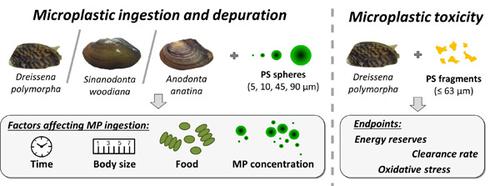当前位置:
X-MOL 学术
›
Environ. Toxicol. Chem.
›
论文详情
Our official English website, www.x-mol.net, welcomes your
feedback! (Note: you will need to create a separate account there.)
Ingestion and Toxicity of Polystyrene Microplastics in Freshwater Bivalves
Environmental Toxicology and Chemistry ( IF 3.6 ) Pub Date : 2021-04-30 , DOI: 10.1002/etc.5076 Annkatrin Weber 1 , Nina Jeckel 1 , Carolin Weil 1 , Simon Umbach 1 , Nicole Brennholt 2 , Georg Reifferscheid 2 , Martin Wagner 3
Environmental Toxicology and Chemistry ( IF 3.6 ) Pub Date : 2021-04-30 , DOI: 10.1002/etc.5076 Annkatrin Weber 1 , Nina Jeckel 1 , Carolin Weil 1 , Simon Umbach 1 , Nicole Brennholt 2 , Georg Reifferscheid 2 , Martin Wagner 3
Affiliation

|
The ubiquity of microplastics in aquatic ecosystems has raised concerns over their interaction with biota. However, microplastics research on freshwater species, especially mollusks, is still scarce. We, therefore, investigated the factors affecting microplastics ingestion in the freshwater mussel Dreissena polymorpha. Using polystyrene spheres (5, 10, 45, 90 µm), we determined the body burden of microplastics in the mussels in relation to 1) exposure and depuration time, 2) body size, 3) food abundance, and 4) microplastic concentrations. D. polymorpha rapidly ingested microplastics and excreted most particles within 12 h. A few microplastics were retained for up to 1 wk. Smaller individuals had a higher relative body burden of microplastics than larger individuals. The uptake of microplastics was concentration-dependent, whereas an additional food supply (algae) reduced it. We also compared the ingestion of microplastics by D. polymorpha with 2 other freshwater species (Anodonta anatina, Sinanodonta woodiana), highlighting that absolute and relative uptake depends on the species and the size of the mussels. In addition, we determined toxicity of polystyrene fragments (≤63 µm, 6.4–100 000 p mL–1) and diatomite (natural particle, 100 000 p mL–1) in D. polymorpha after 1, 3, 7, and 42 d of exposure, investigating clearance rate, energy reserves, and oxidative stress. Despite ingesting large quantities, exposure to polystyrene fragments only affected the clearance rate of D. polymorpha. Further, results of the microplastic and diatomite exposure did not differ significantly. Therefore, D. polymorpha is unaffected by or can compensate for polystyrene fragment toxicity even at concentrations above current environmental levels. Environ Toxicol Chem 2021;40:2247–2260. © 2021 The Authors. Environmental Toxicology and Chemistry published by Wiley Periodicals LLC on behalf of SETAC.
中文翻译:

淡水双壳贝类中聚苯乙烯微塑料的摄入和毒性
水生生态系统中无处不在的微塑料引起了人们对其与生物群相互作用的担忧。然而,对淡水物种,尤其是软体动物的微塑料研究仍然很少。因此,我们研究了影响淡水贻贝Dreissena polymorpha中微塑料摄入的因素。使用聚苯乙烯球(5、10、45、90 µm),我们确定了贻贝中微塑料的身体负担与 1)暴露和净化时间、2)体型、3)食物丰度和 4)微塑料浓度有关。D. 多形快速摄入微塑料并在 12 小时内排出大部分颗粒。一些微塑料被保留长达 1 周。较小的个体比较大的个体具有更高的微塑料相对身体负担。微塑料的吸收依赖于浓度,而额外的食物供应(藻类)减少了它。我们还将D. polymorpha对微塑料的摄入与其他 2 种淡水物种(Anodonta anatina、Sinanodonta woodiana)进行了比较,强调绝对和相对吸收取决于贻贝的物种和大小。此外,我们还测定了聚苯乙烯碎片(≤63 µm,6.4–100 000 p mL –1)和硅藻土(天然颗粒,100 000 p mL –1)在D. polymorpha暴露 1、3、7 和 42 天后,调查清除率、能量储备和氧化应激。尽管摄入大量,但接触聚苯乙烯碎片仅影响D. polymorpha的清除率。此外,微塑料和硅藻土暴露的结果没有显着差异。因此,即使在高于当前环境水平的浓度下, D. polymorpha也不受聚苯乙烯片段毒性的影响或可以补偿聚苯乙烯片段毒性。环境毒物化学2021;40:2247–2260。© 2021 作者。Wiley Periodicals LLC 代表 SETAC 出版的Environmental Toxicology and Chemistry 。
更新日期:2021-04-30
中文翻译:

淡水双壳贝类中聚苯乙烯微塑料的摄入和毒性
水生生态系统中无处不在的微塑料引起了人们对其与生物群相互作用的担忧。然而,对淡水物种,尤其是软体动物的微塑料研究仍然很少。因此,我们研究了影响淡水贻贝Dreissena polymorpha中微塑料摄入的因素。使用聚苯乙烯球(5、10、45、90 µm),我们确定了贻贝中微塑料的身体负担与 1)暴露和净化时间、2)体型、3)食物丰度和 4)微塑料浓度有关。D. 多形快速摄入微塑料并在 12 小时内排出大部分颗粒。一些微塑料被保留长达 1 周。较小的个体比较大的个体具有更高的微塑料相对身体负担。微塑料的吸收依赖于浓度,而额外的食物供应(藻类)减少了它。我们还将D. polymorpha对微塑料的摄入与其他 2 种淡水物种(Anodonta anatina、Sinanodonta woodiana)进行了比较,强调绝对和相对吸收取决于贻贝的物种和大小。此外,我们还测定了聚苯乙烯碎片(≤63 µm,6.4–100 000 p mL –1)和硅藻土(天然颗粒,100 000 p mL –1)在D. polymorpha暴露 1、3、7 和 42 天后,调查清除率、能量储备和氧化应激。尽管摄入大量,但接触聚苯乙烯碎片仅影响D. polymorpha的清除率。此外,微塑料和硅藻土暴露的结果没有显着差异。因此,即使在高于当前环境水平的浓度下, D. polymorpha也不受聚苯乙烯片段毒性的影响或可以补偿聚苯乙烯片段毒性。环境毒物化学2021;40:2247–2260。© 2021 作者。Wiley Periodicals LLC 代表 SETAC 出版的Environmental Toxicology and Chemistry 。











































 京公网安备 11010802027423号
京公网安备 11010802027423号